& Construction

Integrated BIM tools, including Revit, AutoCAD, and Civil 3D
& Manufacturing

Professional CAD/CAM tools built on Inventor and AutoCAD
8 min read
InfoDrainage, our comprehensive site-scale drainage design and analysis software, was just approved for use in the City of Raleigh, North Carolina’s Stormwater Design Manual. Huzzah! This manual joins a growing list of approving authorities recognizing the capabilities of InfoDrainage and explicitly approving it for use on projects in their region.
This begs the question: Can you only use InfoDrainage on public projects where it’s been explicitly listed as an option? If that’s the case, how might you go about getting InfoDrainage on the list so you can take advantage of its superior workflows and integrations?
In this blog, we’re going to walk through when and where InfoDrainage is approved for use, how to approach lists of approved software in drainage manuals, and suggest a surprisingly simple process of getting InfoDrainage on your local list of approved software. To start, let’s talk about some of the regions in the US where InfoDrainage has been approved for use.
InfoDrainage has always been popular in the UK with drainage designers, but its profile has been growing significantly in the US in the last few years thanks to its integrations with Civil 3D and the overarching trend of drainage designers adopting more nature-based solutions, which InfoDrainage excels at. We’ve noticed that it is beginning to show up more and more in US-based drainage design manuals. This is a welcome surprise because drainage design manuals do not always get updated on a regular basis. It’s not uncommon to encounter manuals that were written over a decade prior, with only a few very minor additions made over the years. To see InfoDrainage be added to more manuals makes us happy.
Our solutions and support team has been sifting through regional drainage design manuals here in the US to compile a list of locations where we know InfoDrainage is approved for hydraulic analysis on public works projects, either explicitly or implicitly. We’ll provide a few examples that we’ve found, although this is far from a comprehensive list:
| Approving agency | State | Approval type | InfoDrainage accepted |
|---|---|---|---|
| City of Norfolk | VA | Criteria-based | Yes |
| Charleston | SC | Criteria-based | Yes |
| Davenport | IA | Criteria-based | Yes |
| Baton Rouge | LA | Criteria-based | Yes |
| Virginia Beach | VA | Criteria-based | Yes |
| Ithaca | NY | Criteria-based | Yes |
| Raleigh | NC | Explicit list | Yes |
| Fairfax County | VA | Criteria-based | Yes |
| Cuyahoga County (Cleveland) | OH | Criteria-based | Yes |
| Norfolk | NE | Criteria-based | Yes |
You might have noticed something about this chart: criteria based and explicit list as the two options under the approval type. What does that mean? This leads us to our next topic of discussion and serves as a great example as to why that above list isn’t – and can’t be – comprehensive.
Instead of explicitly listing specific software tools, many approving authorities specify approved software calculation capabilities and results delivery methods. Or to put it another way, they list quantitative and qualitative traits rather than explicitly listing approved tools. But chances are that InfoDrainage meets the approved calculation and reporting requirements for your local approval authority, even if it’s not listed.
If you read through the vast number of US regional and local drainage manuals, we think you’ll come away with an understanding that software approval exists in three key forms.
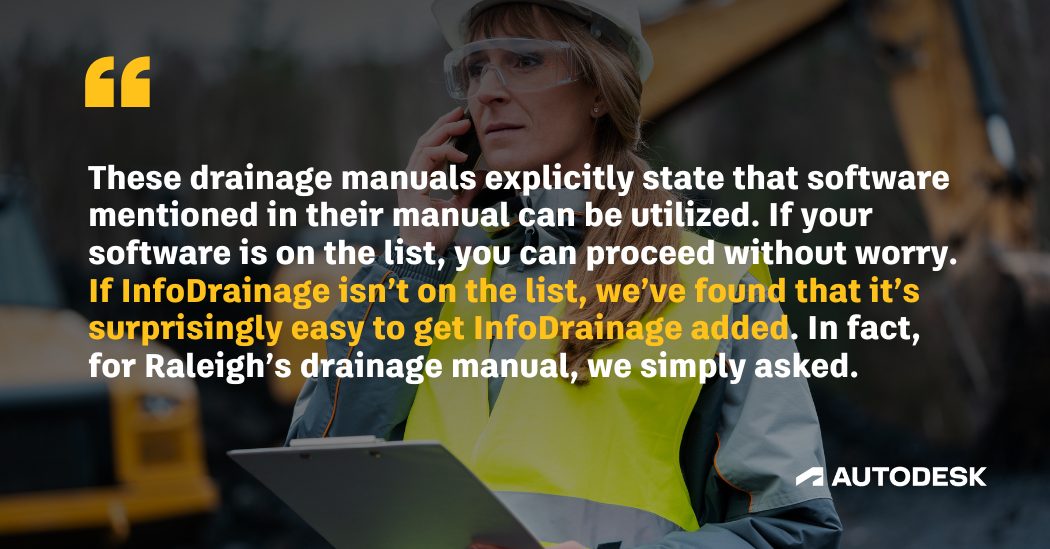
These drainage manuals explicitly state that software mentioned in their manual can be utilized. If your software is on the list, you can proceed without worry. If InfoDrainage isn’t on the list, we’ve found that it’s surprisingly easy to get InfoDrainage added. In fact, for Raleigh’s drainage manual, we simply asked.
Approving authorities generally want to allow you to be as efficient and effective as possible with drainage design software, but there are so many tools on the market that they may be unaware of what’s out there. Or they simply may not have updated their manual in a long time.

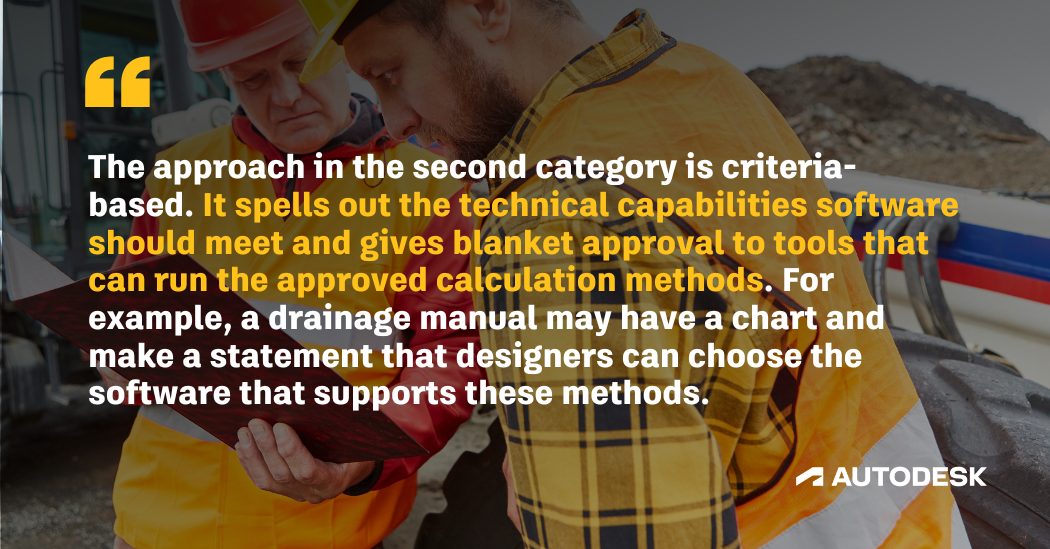
This is one of the most common forms of drainage manual software approvals, laying out technical requirements of the software, but leaving it up to the modeler or engineer to decide which tool to use.
The approach in the second category is criteria-based. It spells out the technical capabilities software should meet and gives blanket approval to tools that can run the approved calculation methods. For example, a drainage manual may have a chart – just like the one below – and make a statement that designers can choose the software that supports these methods.
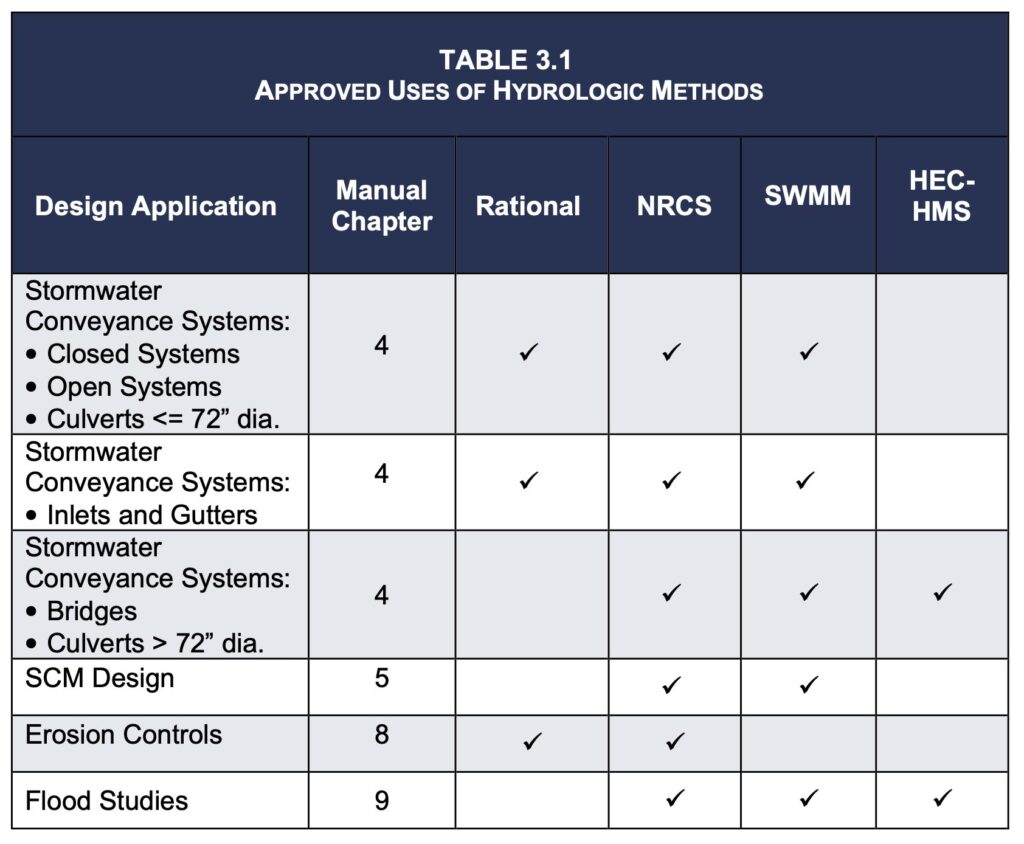
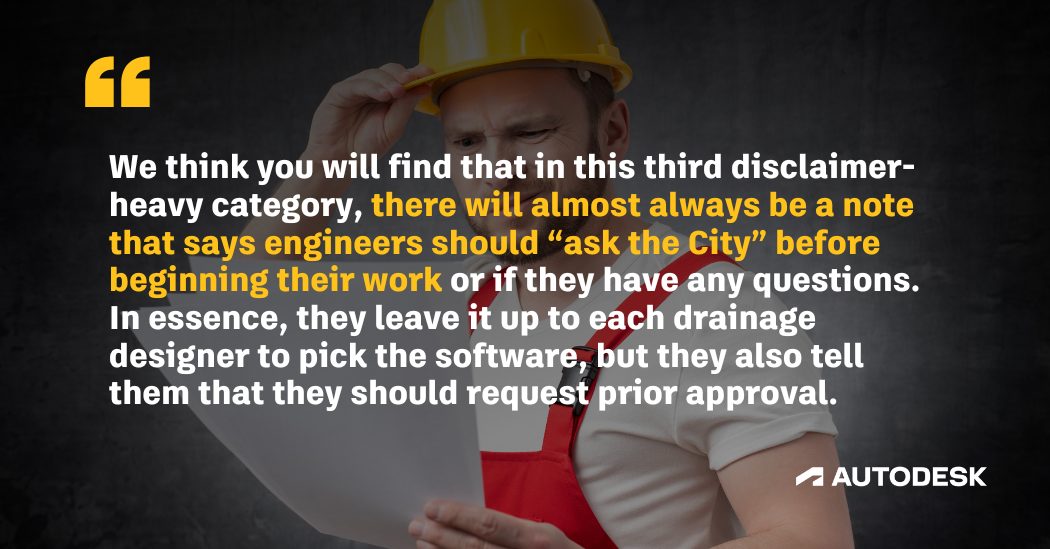
We think there is a third category of manuals, one that is a bit of a mish-mash of both approaches. It usually has strong recommendations around methods but tepid recommendations around which software to use.
In these situations, what we’ve observed is that they often list calculation methods they absolutely require from drainage designers, sometimes in very strict terms, but then they are hesitant to make specific recommendations about which software designers should use to make those calculations.
In this third “uncertain” category, we often see HEC-HMS or HY-8 presented as options because they are perceived as naturally government-approved, but then the manual does not include a bullet-point list of additional suggested/recommended/preferred software.
Why is that? We think there are important (ultimately unknowable) reasons stormwater manuals sometimes avoid making explicit recommendations:
There are lots of other possible reasons. It could be that the project manager who was originally in charge of shepherding the manual to publication either didn’t have enough information or didn’t ask someone internally to weigh in on the question – way back in 2019 when the manual was last updated.
In situations like these, we think the document collaborators who were responsible for collecting the requirements do their best to find simple compromises by adding disclaimers whenever they aren’t 100% sure. In fact, we think you will find that in this third disclaimer-heavy category, there will almost always be a note that says engineers should “ask the City” before beginning their work or if they have any questions. In essence, they leave it up to each drainage designer to pick the software, but they also tell them that they should request prior approval.

We think that is exactly what you should do when you find yourself in this third situation – the disclaimer-heavy situation: Just ask.
Clarify what they want by asking them nicely, “Can I use InfoDrainage to create my model because I’ve found that it’s more accurate and comprehensive, particularly when trying to incorporate nature-based solutions?”
Incidentally, some manuals do list methods that are specifically not allowed (eg, Chainsaw Routing Method), which underscores the importance of both reading the manual carefully and confirming any details you aren’t 100% certain about.

We’re eager to see you utilize InfoDrainage on your public works project, not just because we made the tool, but also because our team truly believes in the future of sustainable, efficient, and optimized drainage systems and the effect they can have on our world and workflows.
If you’re ready to use InfoDrainage on your project but don’t see it listed in the manual, chances are your experience will be similar to ours: all you have to do is ask.
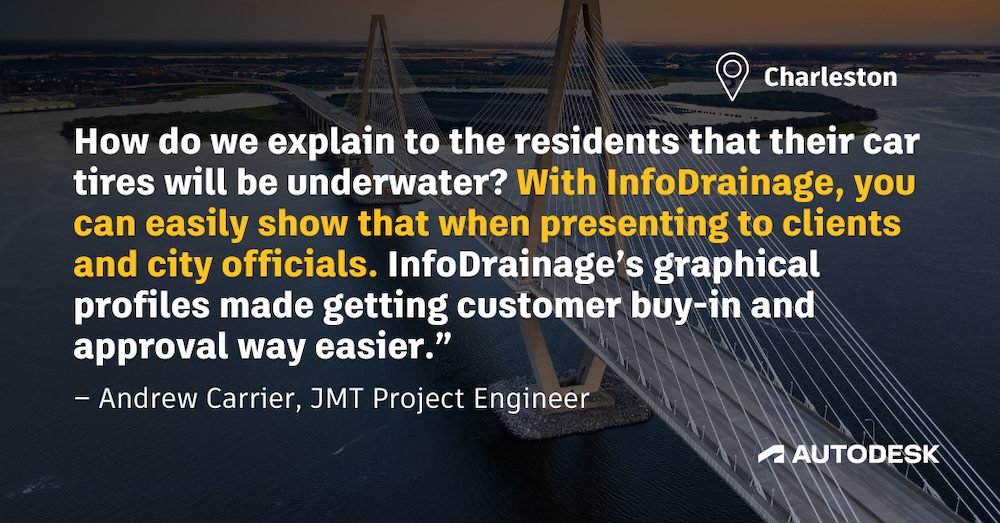
This Charleston Sea Wall project may be a good example of InfoDrainage’s accelerated growth in the US, which takes advantage of its close integration with Civil 3D. When drainage designers can collaborate across the entire project lifecycle, they get involved earlier and have a stronger voice, which is one reason JMT chose InfoDrainage for the stormwater drainage design portion of this historic project.
If you’ve made it this far in the blog, you might be starting to wonder: what calculations can InfoDrainage even do? Well, rather than point you to yet another blog post, we’re going to compile a high-level overview of InfoDrainage’s technical calculation capabilities below with links to the appropriate docs.
| Region | Rainfall types in InfoDrainage |
|---|---|
| US | NOAA rainfall |
| US, Global | SCS Rainfall |
| China/Canada | Chinese Rainfall (aka Chicago Rainfall) |
| UK | FSR Rainfall |
| UK | FEH Rainfall |
| Australia | ARR Rainfall |
| France | Desbordes |
| Runoff method in InfoDrainage |
|---|
| SWMM Method |
| Rational Method |
| Modified Rational Method |
| Laurenson Method |
| Green Roof Method |
| ReFH Method |
| ReFH2 Method |
| FEH Method |
| FSR Method |
| Time Area Diagram Method |
| Santa Barbara Unit Hydrograph Method |
| SCS Method (aka curve number method with calculator) |
| Time of Concentration Method (with calculator) |
Below, we’ve compiled other important calculations and capabilities of InfoDrainage, along with links to their appropriate support files to learn more about how they work and are leveraged inside of the software.
Sign up for the One Water Blog newsletter, and we'll keep you updated about our top stories, along with the best content we find online. We only send out a newsletter when we have something interesting to share.
May we collect and use your data?
Learn more about the Third Party Services we use and our Privacy Statement.May we collect and use your data to tailor your experience?
Explore the benefits of a customized experience by managing your privacy settings for this site or visit our Privacy Statement to learn more about your options.